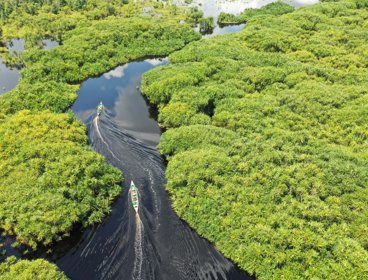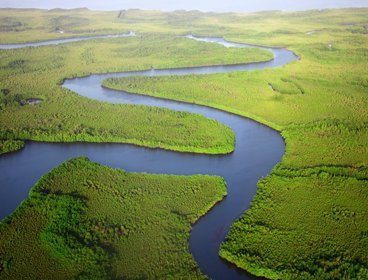Introducing the Mekong River
The Mekong is a 4,350km long river running from the eastern edge of the Tibetan plateau through South East Asia to its mouth at the Mekong delta, Vietnam in the South China Sea. It flows through China, Myanmar, Thailand, Laos, Cambodia and Vietnam, draining over 800,000km2 of land in the world’s twelfth largest drainage basin.
The large size of the Mekong River and its basin means that it has an important role to play in both local water transfer systems and the global hydrological cycle. The volumes of water that are transported along its length are sizable and researchers have suggested that even small fluctuations in the general pattern of hydrological processes in the river basin can have a wide ranging impact, such as on fishing stock levels and precipitation levels.
The Mekong River basin naturally fluctuates between periods of flooding and periods of relative aridity, each lasting roughly six months and coinciding with the monsoonal rainfall for which this area of Asia is famous. This fluctuation is known as a ‘flood pulse’ (Junk, 1989) due to its regularity and predictability. The large biannual changes create a unique ecosystem, with some species such as migratory fish occupying a particular niche created by the fluctuation between terrestrial and aquatic conditions.
How does the Mekong serve people economically?
Around sixty million people rely on the Mekong for food, water and increasingly for energy, and it is in populations that live closest to the river that the greatest dependency on its waters is found. Seventeen million people live on the Mekong delta itself, a 39,000km2 stretch of sediment build up on the south west tip of Vietnam. The delta provides the ground, nutrients and waters needed for almost all of the rice eaten by the people of Vietnam, although much of it is exported into the international market.
The Mekong basin is also essential for Vietnam’s fishing industry. Two million tonnes of fish are landed out of the basin every year with an estimated retail value of over US$4billion (WWF, 2014): almost the same quantity as the whole of Africa. Tonie Sap Lake in central Cambodia is fed by a tributary of the Mekong and is South East Asia’s largest freshwater body. Around three million people rely on its waters for fishing and irrigation.
The flood plain either side of the Mekong’s main channel is home to farmers growing a wide variety of foods. Fields are naturally irrigated by large channels that split from the Mekong and the flood plain becomes a key store of nutrient rich sediment during the monsoon floods. As the floods retreat, the majority of the water drains back into the main channel, though many farmers dig artificial storage ponds to allow them to water their crops throughout the drier season.
Why is the Mekong so biodiverse?
As well as having economic value, the Mekong is also environmentally important. The river and its basin represent a globally significant biodiversity hotspot with more species per unit area than the Amazon basin.
Much of this is biodiversity stems from the special ‘flood pulse’ ecosystem that the river system shapes. On average there is a twelve metre difference between the water level in the dry and wet seasons and the discharge level at the mouth increases eight fold to 42,000 cumecs. Niche habitats are created by the periodic wet and dry seasons and the changes in sediment distribution which they bring. With the flood water comes a nutrient rich sediment layer which increases primary productivity on the flood plain and likewise biodiversity. The regular replenishment of sediment by floodwaters on the floodplain accounts for about twenty percent of the annual river sediment budget, with five percent settling within Tonie Sap Lake and around seventy-five percent ending up as the basis of the delta itself.
Managing the threats to the Mekong River
The functionality of the river basin as an economic and biodiverse system relies on its annual water and sediment flooding patterns and so preserving this pattern is of extreme importance. Unlike residents in some more developed countries, the people who live around in the Mekong basin have come to adapt and be relatively resilient to their annual floods and many understand the need for the flooding for the future of their own livelihoods. Therefore any action that looks to threaten the ‘flood pulse’ is viewed quite critically.
Until 1990 the Mekong River was in a fairly natural state. A total of five dams were in place at that stage, averaging seventy metres in height and appearing on tributaries some distance from the delta. The dams created fishing lakes as well as much needed hydroelectric power, the latter of which has the been the sole focus for damming in subsequent years. The total number of dams stood at thirty one in 2014, with the average size and scale of their water capacity getting larger over time. A further 134 dams are planned to be built in the future, causing concern amongst local people, who are often displaced by their building as well as international environmental campaign groups who are looking at the long term impacts of such a sequestration of the river.

Comparing the dams built before 1990 and those between 2010 and 2014
If the dams go ahead as planned the amount of sediment held behind them will go from negligible to around 90km3 in 2030, with each dam in its own right holding back more sediment exponentially over time. It is predicted that this will have a devastating effect on the biodiversity within the region as well as the livelihoods of the people who rely on the farming and fishing the flood waters allow. The routes of migratory fish will be heavily disrupted should all the proposed dams be built, leading to a 26 to 42% decrease in the fish yields for most fishermen (ICEM, 2010): a highly significant figure given that fish is often the main, if not only, source of animal protein in the diets of people living in the river basin. The result may be that some species are overfished compared to others, leading to significant misbalances in the riparian ecosystem.
The dams are largely needed to meet the rising energy demands of South East Asia, and particularly Chinese industry. However the dams will disproportionately impact on the poorest people in the river basin negatively, while the power generation possible by the dams will disproportionately favour the richer.
Dams also threaten the ability of people living on the delta to adapt to the possible effects of climate change. More than half of the Mekong delta lies at a level less than two metres below sea level making it highly vulnerable to rising sea levels in the region. If the sediment that vitally feeds the delta is held back by a series of dams along the river’s length, the height of the delta does not build up and the erosive action of the sea is felt more acutely by those living on the delta.
The lower levels of freshwater washing over the delta also increase the chances of saltwater intrusion, whereby brackish (partially saline water) is found further and further upstream in the delta system. This would have a huge impact on the ability of famers to grow rice, or indeed any crop, on the delta.
Conclusion
The case of the Mekong River highlights a number of issues associated with working with large river basin systems. Recognition of their ecological and economic importance is an essential starting point when considering the impact new, large scale work projects like dams will have on the environment and the people who rely on the rivers for their livelihoods. Many campaigners and researchers recognise the need for the dams in some senses but also advocate that their exact placement and size could be altered to be more sustainable and appropriate. For example most new dams could be fitted with sediment flushing or sediment bypassing designs that restrict water flow for the purpose of power generation, but also ensure that sediment is allowed to continue passing through the river system and not get held up behind the dams.
Focussing one’s efforts on the ‘critical’ dams where most impact would be felt by their construction is a good starting point and may go some way towards ensuring that disruption to the river system is kept to a minimum. A greater challenge is to ensure that geopolitical relationships are conducive to managing a trans-boundary river system. With six nations trying to manage the Mekong River for their own purposes, as well as numerous concerned countries and parties outside the region, the need for coherent and unified management through agencies such as the Mekong River Commission is never greater.
References
International Centre for Environmental Management (2010) Strategic Environmental Impact Assessment for Hydropower on the Mekong Mainstream, Mekong River Commission, Hanoi
Junk, W. Bayley, P. and Sparks, R. (1989) The flood pulse concept in river floodplain systems, in Dodge, D. (ed) Proceedings of the International Large River Symposium, Canadian Special Publication of Fisheries and Aquatic Sciences 106, p110-127
Unless otherwise stated, all data in the above piece relates to figures taken from Professor Steve Darby’s lecture (March 2014)
Key Words
Biodiversity
The wide variety of plant and animal species in their natural environments.
Dam
A barrier that holds back water within an aquatic system, often for the purpose of hydroelectric power generation and flood control.
Delta
An area of sediment and silt deposit at the mouth of a river.
Ecosystem services
A way in which an ecosystem helps human beings to live, for example through removing harmful gases from the atmosphere.
Hotspot
A place that is particularly diverse in ecology but which is also under significant threat.
Hydroelectric power
Energy that is produced by the gravitational force of water falling through a gradient for example through a turbine system in a dam.
Monsoon
The season experienced typically in south-east Asia where heavy rain falls with predictable frequency.
Saltwater intrusion
The movement of saline water into freshwater aquifers as a result of over extraction of freshwater from sources.
Sediment
Materials that have entered a river system as a result of erosion and which can be deposited in slow moving water or at the river’s mouth.
Lesson Ideas
Students might want to research the Irrawaddy River Dolphin and create a factfile on its ecological niche. Students can think about all the changes that could happen as a result of the proposed dams and then consider where on the IUCN red book scale they would place the dolphin now and in 2030 when the dams are built.
Students can research the extent of sea level rise on the Mekong delta and the cascade of impacts it would have, starting locally and ending globally. Students should be asked to consider where refugees from the region would go and the impact on the cost of shopping in British supermarkets.
Playing the role of different people who use the Mekong River, students can write down three (character specific) reasons why a dam should or should not be built in their locality. Students can then discuss to find who has the strongest case.
Links
Strategic Environmental Impact Assessment for Hydropower on the Mekong Mainstream




